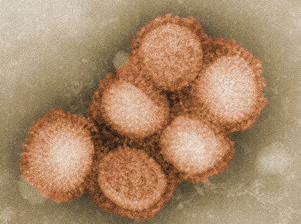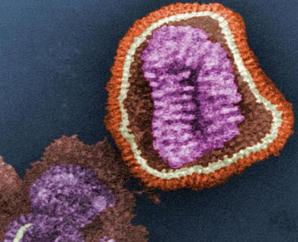
The H1N1 Virus
In the spring of 2009, a descendent of the Spanish Flu virus, which in 1918 spread to every corner of the world and killed millions of people, suddenly emerged in a highly virulent form across Mexico. This new strain of virus, called A-H1N1 by scientists, was colloquially named the "swine flu" because it was commonly found throughout pig populations worldwide before it moved to humans. The rapid spread of the "swine flu" effectively shut down the Mexican economy and public life, and created widespread fear. Hundreds of people died within the first few weeks. Mexican authorities asked citizens to avoid unnecessary contact with others and sequestered A-H1N1 patients in an attempt to prevent the spread of the virus across the Americas and to other continents. However, due to the fact that A-H1N1 is unusually contagious, these measures were ineffective, and on June 11, 2009, the World Health Organization (WHO) declared A-H1N1 a global pandemic.
On May 14, 2009, after a meeting with WHO, a number of pharmaceutical companies announced that they would begin developing an A-H1N1 vaccine. As of this writing, development of the vaccine has been successful, and it is predicted that as many as two billion doses will be distributed starting in November 2009. Yet many of the fundamental scientific questions about A-H1N1 remain unanswered. Why can the virus spread so quickly and widely? Why does it affect the young more heavily than the old? How will it be contained in the long run? A number of ethical and societal questions have also generated fierce debate. How many people does a disease need to affect before the efforts involved in developing and distributing a vaccine are justified? To what degree should governments intervene in private lives for the sake of public health? Some vocal constituencies argue that governments are not doing enough to plan for the global pandemic; others argue against the use of vaccines because they doubt their effectiveness or because they feel that vaccination should not be forced by a government upon its citizens.
The growing number of people affected by A-H1N1 means that these questions are relevant to all of us. In this Spotlight, you will find a range of resources intended to help you understand the broad scope of issues and questions posed by the A-H1N1 virus.
Image: C. S. Goldsmith and A. Balish/CDC.
What is it?
Nature highlights the function, distribution, and worst outcome of H1N1 (pdf).
The Wellcome Trust provides a great overview of key facts and concerns (pdf).
See how H1N1 compares to other similar influenza viruses, like seasonal flu.
Vaccination Resources
Search for national and local information about the H1N1 virus and vaccine. A useful feature allows you to search for vaccine availability in every state.
This video covers widespread concerns and doubts about immunization safety. Despite research proving otherwise, some don't believe that vaccines are risk-free.
Get answers to the most pressing questions about the H1N1 vaccine. The director of vaccines at WHO discusses vaccine safety, production, and distribution.
Find out who is most affected by H1N1 and who is most likely to have immunity. The answer might surprise you.
The CDC provides a categorized list of the different health risks that H1N1 poses for certain individuals.
Look at a map of influenza illness and fatalities across the globe to survey the global impact of the flu.
A Nature article presents a threat assessments by country. Doubts are raised about the effectiveness of government preparations (pdf).
WHO provides weekly assessments of the pandemic with updates focused on the most recent instances of the flu.
The Massachusetts Department of Public Health blogs daily about the virus and its effects on human health.
Social and economic impact
There are unpublished data about health risks associated with H1N1 vaccination, and legal issues surrounding obligatory inoculations. The controversy is ongoing.
What would the economic effects of a pandemic mean to national and international business? International authorities are asking infected people to stay home.
Read a general overview about how ignorance of H1N1 generates pervasive fear that may lead to dangerous consequences when people are misinformed.



























